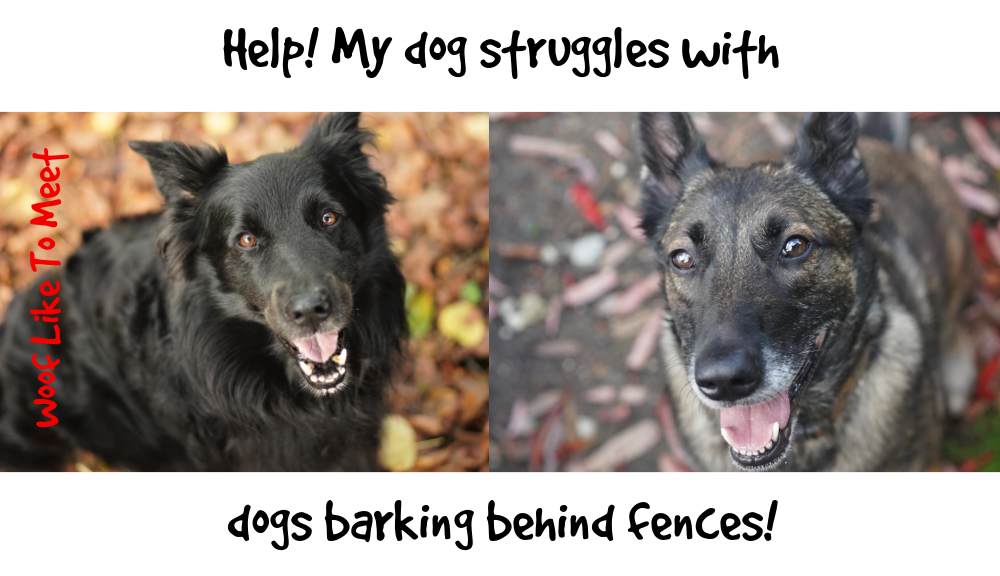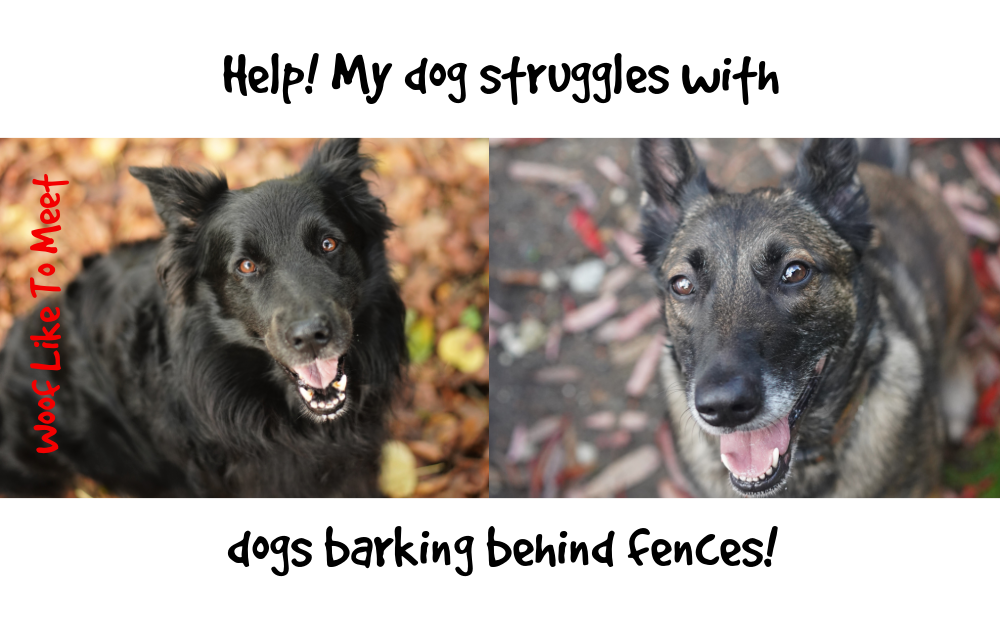Many dogs really struggle to cope when walking past homes where a dog is loose in the garden.
In fact, there are two dogs struggling here.
One is your dog as you valiantly try to get past. The other is the dog struggling to cope with other dogs outside the property.
There are lots of people who are trying to find ways to stop their dog barking at pedestrians and dogs outside the property. If you’re on the inside of the fence, you can use my alert and alarm barking protocol.
This ten-step protocol will make a difference, I absolutely promise you. There’s no way I could live sanely in a densely populated area with a very large number of dogs around the neighbourhood who bark periodically if I didn’t have this protocol in place. It’s been a sanity saver, if not a life saver.
If you want to know how to stop your dog barking when people pass by with their dogs, bookmark that page and follow it to the letter!
I will say one thing: if every guardian where I live had this in place, there wouldn’t be a struggle trying to get past.
The big question for those of us with dogs who react as they walk past fences is: do you avoid, do you hurry past or do you try to do some training to help your dog cope?
Avoiding the home with the dog barking behind a fence seems like a cop-out. We don’t thnk our dog is learning anything. We know we’re not helping our dogs out if we don’t help them cope.
Hurrying past is also a huge challenge. I know dogs who freeze when dogs behind fences start barking at them. One person I know has to then pick his dog up and carry him – all 20kg of dog – past the offending barker.
As someone who has 60kg of dog on a lead, trying to get past when they’re lunging and barking at the fence is a nightmare, let me tell you. I’d love to hurry past! It takes me at least three times as long to get past these houses as it does to get past a normal house.
Even so, slowing down to do training with a dog while a dog outside a home is going nuts is not without its problems.
So which is the best option to take?
When to avoid homes where dogs are barking behind fences
Humans feel a surprising aversion to avoiding places where there are dogs running fence lines and going nuts.
It’s almost like it’s our superior human right or something.
I say this as I was once asked to do a webinar to a triathlon group about what to do if dogs attacked. I explained a lot about territorial behaviour. One man said that he’d been repeatedly attacked by the same dogs as he rode his bike past them every day. He explained that they were unfenced and he wanted to know if pepper spray would be enough to deter them.
I explained that pepper sprays are notoriously unreliable and dependent on wind conditions – he was as likely to get a face of pepper spray as the dogs would. I asked if he had any other route to go. Yes, he explained.
Why didn’t he take that route instead?
Because it was the way he wanted to go.
The detour would have taken him a couple of minutes. That’s all.
He’d rather have got bitten than change his route.
Unlike this gentleman who had a pathological hatred of both dogs and their guardians, as well as a sense of his God-given superiority over animals (although he admitted he wouldn’t ride through a field with a bull in it…), you’re a dog lover. At least, I hope so!
One of my neighbours had a Brittany spaniel who spent most of his day in a fenced yard. The dog had an (ineffective) bark collar. The dog would bark, whine, bark, whine, bark, whine… all while throwing himself against the fence.
Now I don’t know about you, but I am not at all a fan of giving other dogs shocks. I’m certainly not a fan if it’s actually not making a stick of difference.
So, I didn’t go that way.
I also had a neighbour whose dog had an invisible perimeter shock collar. Now that mostly kept that dog from getting out of the garden, which was also surrounded by a couple of horse fields with electric fencing. I say mostly because… once when we walked past, he decided to go for it anyway. He got zapped by his collar, zapped twice by the high-voltage electric horse fencing itself and we very luckily avoided a fight because I was able to secure my own dogs quickly.
So I did not trust that home or that invisible perimeter shock collar. I did not trust that high-voltage electrified fencing either.
It is not some crushing defeat to choose another way. It is not a crushing defeat to wait until the dog is inside. If avoiding their home also avoids penalties and punishments for the dog who lives there, and you have other routes to go, put your human superiorities and foibles to one side. Do yourself a favour and take the easy route.
And, just because there are no shock collars or shouting owners who come out and punish the dog, it doesn’t mean that you have a green light. Sure, you can possibly train the dog who lives there to accept you going past by throwing them treats or whatever, but you also have to consider if the dog has allergies you don’t know about.
Also, even if you were to change your passing into an event that caused paroxysms of joy, you may well cause just as much jumping up and barking which is just as difficult for your own dog to cope with.
When to do training outside the home of a dog going nuts behind a fence
Never.
I’m guessing you’re hoping the fence is secure.
Again, your dog may well be able to cope with it, but you have to consider that the other dog cannot.
I don’t know about you, but I’m not so selfish that I’d stand there in front of a fence with my own dog eating biscuits driving another dog nuts.
You know how I judge my dog-walking neighbours?
By what they do when they go past homes with dogs barking in windows and at fences.
You know when I fell in love with my neighbours and their Frenchie? When the dog was dawdling a little and his guardian said, ‘Come on. You’re winding those dogs up!’
You know when I realised the two women who walk their dogs were not my kind of people? When they stood outside a home gossipping for ten minutes while the dog inside was losing his mind. Plus, they also didn’t bag up what their own dogs left behind… said it all.
Take heed. You’re judged on your choices by mean old ladies like me.
You may feel like you’re doing your own dog a favour and teaching your own dogs how to cope, but please remember that to do so comes at the expense of the other dog’s peace of mind. It’s not their fault their guardians don’t know about the alert and alarm barking protocol.
Also, it’s likely to be highly aversive for your own dog.
When to hurry past
If there’s literally no other way you can go and you are safe to pass. If it’s a regular spot, either change your route or change the time you walk. Sometimes, it’s just that the dog is out there at particular times. In rural France, there are plenty of places where dogs live outside in permanence, and that can make it tough. If your dog is likely to lunge and bark too, then it’s definitely time to give it a miss.
I’d be tempted also to hurry past if the dog only has a very small area where they can see you. If you’ve got to try and hurry past a dog who is racing 300 or 400m while you try desperately to get your own dog past, you’ll know it’s much easier to get past a solid stone wall that has a 1m wide ironwork gate and you’re not going to cause either dog distress for long.
‘But there’s no other way we can go!’ or ‘I want my dog to be okay in case of emergency!’
There are those of us who would never be able to get out of our homes if we avoided every other home with a barking dog living permanently outside. Not all of us have dogs who are happy in cars. Not all of us have cars. Not all of us want to use our cars just to get our dog in and out of the neighbourhood.
There are also those of us who have relatively peaceful neighbourhoods, and then the odd time there’s a dog outside.
The first thing to realise is that if you are trying to work with your barking and lunging dog as they’re fence-fighting with another barking dog, you are asking far too much of your own dog.
What you want is for your dog to be able to work with you in a structured way around distractions. It shouldn’t matter what those distractions are, but you will have to acknowledge that walking past a home with a large, ferocious dog fence-running and barking for 200m is the pinnacle of focus work.
One important thing can be to have a dog that can walk on both sides of you. If you’ve got a narrow pavement between you and the dog, if you can’t cross over the road or you don’t have much space, being able to keep your own dog away from the fence is an essential. Although you are not much of an obstacle, it’s better to position yourself between your dog and the fence than it is to have the two dogs separated only by the fence.
Having a dog who can u-turn under pressure is also an important skill. Trying to move any dog around who’s already in the process of yelling at another through the fence is not the easiest.
Finally, having a simple and reliable set of small, easy, predictable behaviours is also useful. I use ‘find it!’ and ‘1, 2, 3’ to use treat placement to help my dog move forward quickly as we move away (find it!) and to keep behind me as we approach (1, 2, 3). You can see these in more detail in this post.
You may also want to keep them moving with a hand touch. Amy Cook has her lovely ‘Magnet Hand’ where she has a hand full of treats that she keeps just in front of her dog’s nose as a lure in case of emergencies.
Whatever you do, though, will need some thought and practice in a variety of contexts, including around other dogs and other fences where there are dogs less bothered by your presence.
It needn’t be a complete trauma to get past your noisy neighbours, but a little bit of preparation will definitely help you out.
I’ve got a favour to ask those of you who’ve read my book Client-Centred Dog Training, which I wrote specifically to help dog trainers with both their business and their engagement. If you have read it, could you drop on over to Amazon and leave a review? It really helps future purchasers know that it’s for them!
And don’t forget to subscribe if you want the occasional newsletter:



